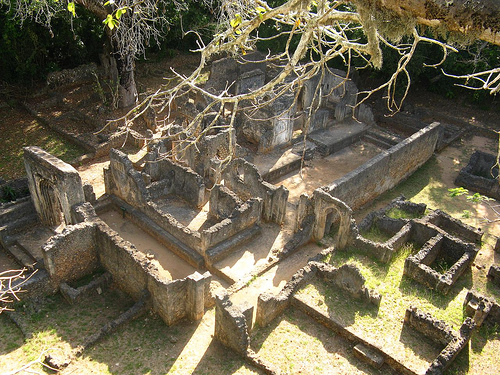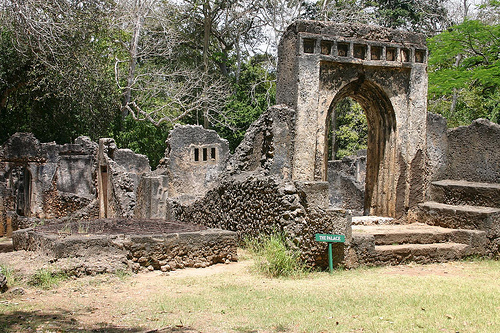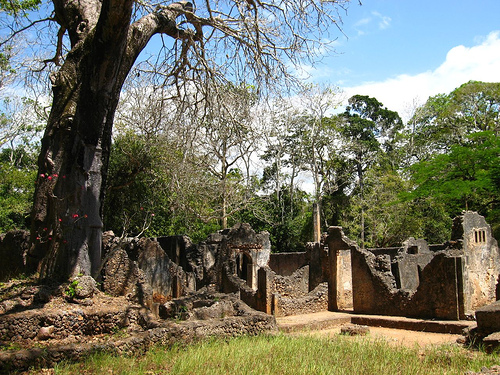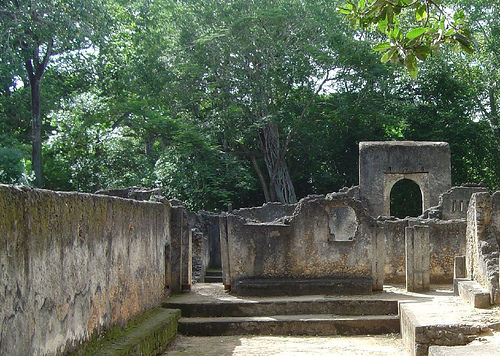

Location: 1 km (1/2 mi) North of Watamu Map
Tel. 042 3246
Open: 7am- 6pm Mon- Sat
The Ruins of Gedi (also spelled Gede), located near the coastal town of Watamu in Kilifi County, Kenya, are one of East Africa’s most significant archaeological sites, offering a window into the sophisticated Swahili civilization of the 13th to 17th centuries. Nestled within a lush, 44-hectare indigenous forest, about 16 km south of Malindi and 100 km northeast of Mombasa, Gedi is a National Monument managed by the National Museums of Kenya. The site, a deserted Swahili city-state, features well-preserved coral stone structures, including mosques, houses, a palace, and tombs, reflecting a prosperous trading hub connected to the Indian Ocean network. Its mysterious abandonment in the 17th century, coupled with its serene forest setting and rich biodiversity, makes Gedi a compelling destination for historians, archaeologists, and eco-tourists. Designated a UNESCO World Heritage Site in 2021, it stands alongside Lamu Old Town as a testament to Swahili cultural heritage.
Gedi was established around the early 13th century and thrived until
its abandonment by the late 17th century. Its origins are debated,
with oral traditions suggesting it was founded by Omani or Somali
immigrants, though archaeological evidence points to a
Bantu-speaking Swahili population with strong Islamic and
cosmopolitan influences. The city’s name, “Gedi” (meaning “precious”
or “valuable” in Swahili), may reflect its wealth, though no
contemporary written records confirm its original name or precise
founding.
Gedi was a key player in the Indian Ocean trade,
linking East Africa with Arabia, Persia, India, and China. It
exported ivory, mangrove poles, gold, and possibly slaves, importing
Chinese porcelain, Persian ceramics, and Indian beads. The city’s
peak population is estimated at 2,500–3,000, a modest but affluent
community sustained by trade, fishing, and agriculture. Its decline
likely resulted from multiple factors: Portuguese colonial
disruptions (16th–17th centuries), shifting trade routes, water
scarcity (due to receding groundwater), or raids by nomadic groups
like the Galla (Oromo). By the 18th century, Gedi was abandoned,
reclaimed by the forest until its rediscovery in the 1920s.
Local Giriama communities knew of Gedi’s ruins, associating them
with ancestral spirits, but the site gained global attention when
British colonial settlers reported it in the 1920s. Systematic
excavations began in the 1940s under James Kirkman, who worked from
1948 to 1959, uncovering the city’s layout and artifacts. Further
digs in the 1960s–1980s by the National Museums of Kenya refined its
chronology, confirming occupation from the 13th to 17th centuries
through radiocarbon dating and imported ceramics (e.g., Chinese
celadon and Ming porcelain).
Excavations revealed a planned
urban center with distinct zones for elites, commoners, and
religious activities. Artifacts, including glass beads, iron tools,
and Islamic pottery, are displayed in the on-site Gedi Museum.
Ongoing conservation addresses erosion and root damage from the
forest, with stabilization of walls and drainage systems to protect
structures. The site’s UNESCO status has spurred international
funding for preservation.

Gedi’s structures, built from coral stone (quarried locally) and
lime mortar, showcase Swahili architectural ingenuity, blending
African, Islamic, and Persian elements. The city, enclosed by two
concentric walls, covers 18 hectares within a larger 44-hectare
forested area. Key features include:
Great Mosque: The
largest structure, dated to the 15th century, features a mihrab
(prayer niche) with coral carvings, a deep well for ablutions, and a
raised platform for sermons. Its three-aisled design and arched
doorways reflect Islamic influences.
Palace: A sprawling complex
with courtyards, audience halls, and private quarters, likely for
the city’s ruler (sheikh or sultan). It includes a sunken court,
storage rooms, and latrines with advanced drainage, indicating elite
status.
Mosques: Seven smaller mosques, including the Mosque of
the Long Conduit (with a water channel), served local neighborhoods,
each with mihrabs and wells.
Houses: Over 20 houses, ranging from
modest to multi-roomed, feature coral walls, arched niches, and
latrines. Elite homes, like the House of the Cistern, had multiple
cisterns and decorative plasterwork, while simpler homes used mud
and wattle.
Pillar Tombs: Distinctive Swahili tombs, some 3
meters tall, are topped with conical or fluted pillars, possibly
marking elite burials. The Dated Tomb (inscribed 802 AH/1399 CE) is
a rare example with a precise date.
City Walls: The inner wall
(2–3 m high) enclosed the elite core, while the outer wall protected
a broader residential area. Gates, like the North Gate, controlled
access.
Wells and Drainage: Over 30 wells tapped groundwater,
critical in the absence of rivers. A sophisticated drainage system
channeled wastewater, reflecting urban planning.
The architecture
emphasizes privacy (courtyards, screened entrances) and hygiene
(latrines, wells), with decorative elements like coral friezes and
Chinese porcelain insets in walls. The forest setting, with baobabs
and tamarind trees, protected the ruins from looting but challenges
preservation due to root intrusion.
Gedi epitomizes the Swahili coast’s cosmopolitan culture:
Trade
Networks: Artifacts like Yuan dynasty celadon (13th–14th centuries),
Ming porcelain (15th–16th centuries), and Venetian beads confirm
trade with Asia and Europe. Gedi’s wealth derived from exporting
local goods and acting as an entrepôt.
Islamic Identity: The
mosques and Arabic inscriptions (e.g., on the Dated Tomb) indicate a
Muslim population, likely converted by the 10th century. Gedi was a
center of Islamic learning, with possible ties to scholars in Lamu
and Pate.
Swahili Society: The city’s layout suggests social
stratification, with elites near the palace and mosques, and
artisans or laborers in outer areas. Domestic artifacts (spindles,
lamps) reveal daily life, including weaving and fishing.
Mystery
of Abandonment: Gedi’s sudden desertion, without signs of
destruction, fuels speculation. Oral traditions mention supernatural
causes, like jinn, while archaeologists cite environmental or
economic shifts.
The site’s artifacts, housed in the Gedi Museum,
include Chinese coins, Persian faience, and Swahili pottery,
illustrating a globalized economy. Gedi’s integration of African and
Islamic aesthetics influenced later Swahili sites like Fort Jesus.

Gedi’s location within an indigenous coral rag forest enhances its
allure. The forest, part of the Arabuko-Sokoke Forest ecosystem,
supports:
Flora: Baobabs, tamarind, and strangler figs
envelop the ruins, with orchids and ferns in the understory. The
forest’s canopy protects structures but requires management to
prevent damage.
Fauna: Over 50 bird species, including the
Fischer’s turaco and African fish eagle, inhabit the area. Mammals
include vervet monkeys, bushbabies, and rare Ader’s duikers.
Butterflies, like the African monarch, and reptiles (agama lizards,
pythons) are common.
Conservation: The Kenya Forest Service and
National Museums of Kenya monitor the forest, controlling invasive
species and illegal logging. The site’s biodiversity attracts
eco-tourists, complementing its historical appeal.
Gedi is open daily from 7:00 AM to 6:00 PM, attracting 20,000–30,000
visitors annually, including school groups, researchers, and
international tourists. Managed as a National Monument since 1927,
it features a museum, visitor center, and guided tours.
Attractions:
Guided Tours: Knowledgeable guides (KES 500–1,000
gratuity) explain the ruins’ history, architecture, and legends.
Self-guided tours use informative plaques.
Gedi Museum: Displays
artifacts like Chinese porcelain, Islamic lamps, and Swahili
jewelry, with exhibits on Swahili culture (entry included in site
fee).
Ruins Exploration: Visitors wander paved paths through the
Great Mosque, palace, and houses, with atmospheric views of coral
walls amid forest vines. The Dated Tomb and Pillar Tombs are
highlights.
Nature Walks: Trails through the forest reveal
wildlife and rare plants, with birdwatching spots near wells (guided
walks KES 1,000).
Cultural Context: The nearby Giriama village
offers cultural tours, including dances and craft demonstrations
(KES 500–1,000).
Entry Fees: KES 500 for Kenyan citizens, KES
1,000 for non-residents, KES 200 for children under 16 (verify with
National Museums of Kenya).
Access: From Mombasa, drive 2 hours
(100 km) via the A109 road to Watamu, then 5 km to Gedi. Matatus
from Mombasa to Watamu (KES 300–500) drop off at the Gedi junction;
boda bodas (KES 100–200) or taxis (KES 500) reach the site. The
turn-off is signposted on the Malindi-Watamu road (coordinates:
3P5X+8P Gede).
Accommodation: Nearby Watamu offers luxury resorts
like Hemingways (KES 20,000–50,000/night), mid-range hotels like
Turtle Bay (KES 5,000–15,000), and budget guesthouses (KES
2,000–5,000). Malindi, 20 km north, has additional options.
Dining: Local eateries in Watamu serve Swahili seafood (e.g., crab
samosas, coconut rice) for KES 500–2,000. The site has a small café
for snacks.

Environmental Threats: Humidity and forest roots erode coral
structures, with 10% of walls damaged since the 1960s. Conservation
includes root barriers and lime mortar repairs, but funding is limited.
Climate Change: Rising sea levels (3–5 mm/year) and coastal erosion, 5
km from the site, threaten the forest ecosystem. Heavy rains increase
flooding, destabilizing ruins.
Tourism Pressure: Foot traffic and
vandalism (e.g., graffiti) strain the site, though ranger patrols have
reduced incidents by 80% since 2015.
Urban Encroachment: Watamu’s
growth brings noise and waste, disrupting Gedi’s serene ambiance. A 2018
buffer zone law limits nearby development.
Underfunding: The National
Museums of Kenya allocates less than KES 10 million annually for Gedi,
insufficient for full restoration or marketing.
Best Time: June–October (dry season) for clear paths and cooler
temperatures (25–30°C). November–March offers lush greenery but higher
humidity. Avoid April–May (rains) for muddy trails.
Essentials: Wear
sturdy shoes for uneven paths, bring water, insect repellent, and a hat
for sun protection. Binoculars enhance birdwatching.
Guides: Hire a
guide for detailed insights, as some structures lack signage. Negotiate
gratuities upfront.
Respect the Site: Avoid touching walls or
climbing ruins to prevent damage. Photography is allowed (no flash in
the museum).
Combine Visits: Pair Gedi with Watamu’s beaches (5 km
away), Malindi’s Vasco da Gama Pillar (20 km), or the Arabuko-Sokoke
Forest (10 km) for birding and rare mammals like the golden-rumped
elephant shrew.
Safety: The site is secure, with rangers present.
Stick to marked paths to avoid snakes or disorientation in the forest.
Preservation: The National Museums of Kenya, with UNESCO support,
maintains the ruins through annual stabilization and vegetation control.
A 2020–2025 conservation plan targets 30% of damaged structures.
Community Engagement: Local Giriama guides and artisans benefit from
tourism, with 50% of entry fees funding community projects like schools
and wells. The Gedi Youth Group promotes eco-awareness.
Reforestation: Over 5,000 indigenous trees planted since 2010 protect
the forest buffer, reducing erosion.
Research: Ongoing studies by the
University of Nairobi and international teams analyze artifacts and
groundwater changes, informing preservation strategies.